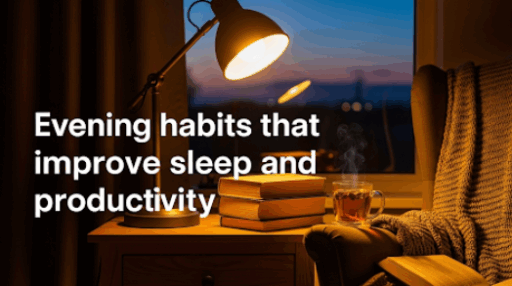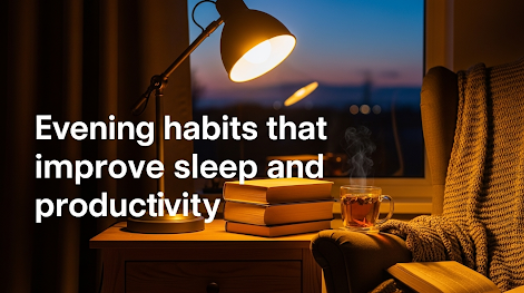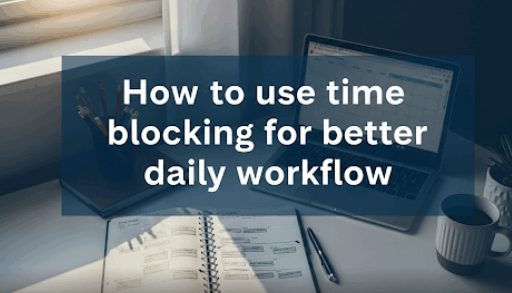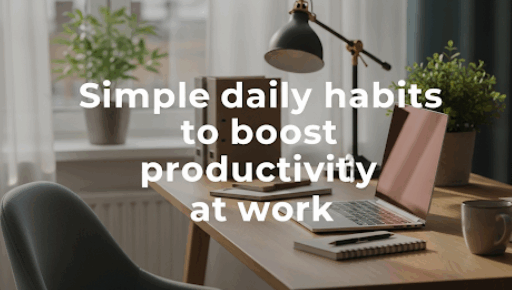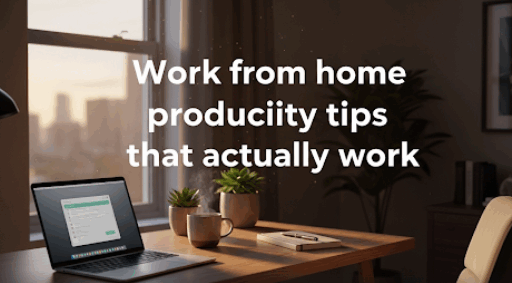Your Blueprint for Better Nights and Brighter Days
Quality sleep means more than just waking up feeling rested — it’s the cornerstone of productivity, focus, and mental health. And yet so many people go to bed each night tossing and turning, only to wake up groggy the next morning, completely losing focus.
Breaking this cycle involves how you spend your hours before bedtime. If you literally pour everything into your day and never take the time to process it, there is a traffic jam. Setting the right nighttime routines can greatly improve your night’s sleep and how well you perform during the following day.
Here’s Your Guide to the Optimal Evening Routine: 10 Science-Backed Sleep Hacks that Will Help You Achieve a Deeper + Faster Sleep, and Earn the Right to The Morning Glory. No matter if you are a working professional, student or parent, these tips will change your nights and boost productivity in your days.
The Connection Between Productivity and Sleep; or, Why Your Evening Is So Important
The two-way link between sleep and productivity: If you sleep less, your focus starts to wear off, decision-making skills start deteriorating and you become less creative. The problem is that high stress and poor nocturnal habits result in one restless night after another.
People who get 7-9 hours of quality sleep perform 23% better on cognitive tasks compared to their sleep-deprived counterparts. Your brain uses sleep time to:
- Consolidate memories from the day
- Clear out metabolic waste products
- Restore energy levels
- Process emotions and stress
- Strengthen neural connections
When you get good at setting up your evening routine, you are effectively programming your body and mind for the next day.
Tame Your Inner Screen Zombie
The Blue Light Problem
The blue light that our phones, tablets, laptops and even TVs emit is one of the biggest enemies to a good night’s sleep. This artificial light fools your brain into believing that it’s still daytime, which in turn hampers the production of melatonin — a hormone that tells your body to fall asleep.
Smart Screen Strategies
Create Device-Free Zones:
- Keep bedrooms completely screen-free
- Designate an area for charging gadgets outside the bedroom
- Instead of using your phone, get a traditional alarm clock
2-Hour No Electronics Before Bed: Turn off electronic equipment at least two hours before going to bed. Whenever you use devices, follow these rules:
- Turn on night mode or blue light filter
- Use the lowest comfortable screen brightness
- Keep the screen at least an arm’s length away
- Use the 20-20-20 rule: Every 20 minutes take a break and shift your gaze to something 20-30 feet away for at least 20 seconds
Alternative Evening Activities:
- Read physical books or magazines
- Practice journaling or creative writing
- Stretching or gentle yoga
- Listen to relaxation podcasts or audiobooks
- Do puzzles or crafts
Creating Your Perfect Sleep Environment
Temperature Control
Room temperature: The air at night must be cool to encourage your body to sleep. The perfect temperature to sleep at is anywhere between 65-68°F.
Cooling Strategies:
- Opt for cotton or bamboo sheets, as they allow your skin to breathe
- Invest in a programmable thermostat
- Use a fan for bedroom circulation
- Take a warm bath 90 minutes before bed (cooling afterward makes you sleepy)
Lighting Optimization
Light exposure at night is crucial for circadian rhythm. Follow these lighting best practices:
Evening Lighting Schedule:
| Time Before Bed | Lighting Strategy | Recommended Actions |
|---|---|---|
| 3+ hours | Normal lighting | Regular daily activities |
| 2-3 hours | Dim warm lights | Begin winding down |
| 1-2 hours | Low light | Use salt lamps or candles |
| 0-1 hour | Near darkness | Prepare for sleep |
Darkness Enhancement:
- Install blackout curtains or shades
- Use an eye mask if needed
- Cover or turn off LEDs on electronics
- Use light-blocking tape for small light sources
Sound Management
While a quiet environment is optimal for sleep, complete silence may not always be necessary.
Noise Control Options:
- White noise machines or apps
- Earplugs designed for sleeping
- Subtle ambient or nature sounds
- Heavy curtains or rugs for sound absorption
The Power of Evening Nutrition
Timing Your Last Meal
The importance of what and when you eat in the evening is paramount, dictating your body’s ability to fall asleep and remain in an optimal state of slumber. Consuming large meals within an hour or two before resting can result in feelings of bloating that hinder digestion and sleep.
Optimal Eating Schedule:
- Eat dinner at least 3-4 hours before bed
- Have a light snack 1-2 hours before sleep if needed
- Skip spicy, acidic or high-fat foods in the evening
- Stay hydrated but cut back on fluids 2 hours before bed
Sleep-Promoting Foods
Few foods really induce sleep, but many foods that make up a healthful diet can contribute to better sleep.
Natural Sleep Enhancers:
- Tart cherries — Contain natural melatonin
- Almonds and walnuts — High in magnesium and healthy fats
- Turkey — Contains tryptophan, an amino acid that promotes sleepiness
- Chamomile tea — Has moderate sedative properties
- Bananas — High in potassium and magnesium for muscle relaxation
- Oatmeal — Complex carbs that support serotonin production
Foods and Drinks to Avoid
Evening No-No’s:
- Coffee, tea, chocolate or caffeinated medications
- Alcohol (helps you fall asleep but disrupts your sleep cycle)
- High-sugar foods (cause energy spikes)
- High liquid intake (causes nighttime bathroom visits)
- Spicy foods (can cause heartburn and discomfort)
Exercise: Getting the Balance Right
The Exercise-Sleep Balance
Exercise does improve sleep — but only if done at the right time. Physical activity can be stimulating and you may have a harder time falling asleep.
Exercise Timing Guidelines:
- Finish intense exercises at least 4 hours before sleep time
- Light to moderate exercise is okay 2-3 hours before bed
- Gentle exercise like walking or stretching is fine closer to bedtime
Evening-Friendly Physical Activities
Gentle Movement Options:
Restorative Yoga Poses:
- Child’s pose (Balasana)
- Legs-up-the-wall pose (Viparita Karani)
- Gentle spinal twist
- Cat-cow stretch
Light Stretching Routine:
- Neck and shoulder rolls
- Forward fold to release tension
- Hip flexor stretches
- Calf stretches
Relaxation Exercises:
- Progressive muscle relaxation
- Gentle breathing exercises
- Tai chi movements
- Simple walking meditation
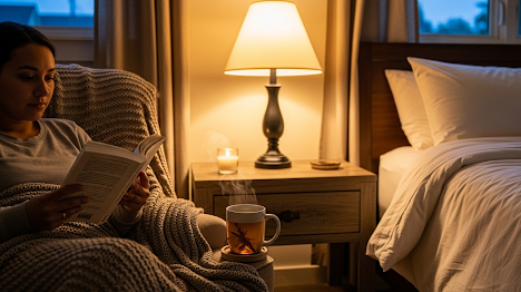
Stress Management and Mental Preparation
The Mind-Body Connection
Late-night anxiety and an overactive mind are some of the most common reasons people have trouble falling asleep. Both better sleep and productivity require effective stress management techniques.
Journaling for Better Sleep
Journaling your thoughts and worries helps empty them from your mind prior to going to bed.
Effective Journaling Techniques:
Brain Dump Method:
- Write continuously for 10-15 minutes
- Don’t worry about grammar or structure
- Include worries, tasks and random thoughts
- Keep a notebook next to your bed
Gratitude Practice:
- Write 3-5 things you are grateful for that day
- Focus on positive moments both big and small
- Pay attention to details, not general statements
Tomorrow’s Success Planning:
- List 3 priorities for the next day
- Write down concerns and their possible solutions
- This prevents midnight worry sessions
Meditation and Mindfulness Practices
Meditation makes a big difference in how well we sleep and how quickly we fall asleep.
Beginner-Friendly Meditation Techniques:
4-7-8 Breathing:
- Exhale completely through your mouth
- Inhale through your nose for 4 counts
- Hold your breath for 7 counts
- Exhale slowly through your mouth for 8 counts
- Repeat 3-4 times
Body Scan Meditation:
- Begin with your toes and work up to your head
- Notice any tension or discomfort
- Consciously relax each body part
- This typically takes 15-20 minutes
Mindfulness Apps and Resources:
- Headspace (guided meditations)
- Calm (sleep stories and meditation)
- Insight Timer (free meditation library)
- Ten Percent Happier (practical meditation)
Building Your Personal Evening Routine
The 90-Minute Wind-Down Protocol
Developing a routine before bed signals your body to prepare for sleep each night. Start about 90 minutes before your target bedtime.
Sample Evening Routine Timeline:
90 minutes before bed:
- Finish eating and drinking (except water)
- Start lowering lights around the house
- Transition to relaxing activities
60 minutes before bed:
- Complete all electronic device usage
- Begin personal hygiene routine
- Practice gentle stretching or yoga
30 minutes before bed:
- Read a book or practice mindfulness
- Do deep breathing or progressive muscle relaxation
- Review the next day’s plans (if not already done)
15 minutes before bed:
- Final bathroom visit
- Ensure your room is cool, dark and quiet
- Get into bed and engage in sleep-preparation activities
Customizing Your Routine
The best nighttime routine for you will differ depending on your lifestyle, family obligations and individual preferences.
Consider These Factors:
- Work schedule and commute time
- Family responsibilities and children’s bedtimes
- Exercise preferences and gym schedules
- Social commitments and relationships
- Personal energy patterns and chronotype
Routine Customization Tips:
- Start Small: Pick only 2-3 new habits
- Be Consistent: Same time every night
- Track Progress: Use sleep diaries or apps
- Make Gradual Changes: Slow adjustments are easier to stick with
- Plan for Disruptions: Have backup strategies for busy or chaotic days
Advanced Sleep Optimization Techniques
Sleep Hygiene Mastery
Professional Sleep Strategies:
Temperature Regulation:
- Use moisture-wicking sleepwear
- Consider a cooling mattress pad
- Adjust room temperature lower overnight
- Benefit from your body’s natural temperature drop
Aromatherapy for Sleep:
- Lavender essential oil is the most researched
- Chamomile and bergamot scents
- Use diffusers, pillow sprays, or sachets
- Ensure the aromas are subtle
Sleep Environment Optimization:
- Invest in a quality mattress and pillows
- Consider weighted blankets for anxiety reduction
- Use plants to purify the air
- Maintain optimal humidity levels
Modern Technology for Sleep Enhancement
Technology enables new methods to enhance sleep and monitor progress.
Sleep Tracking Tools:
- Sleep cycle and rhythm monitoring
- Sleep duration and efficiency
- Time to fall asleep
- Number of nighttime awakenings
- Morning mood and energy levels
- Correlation with daily activities
Troubleshooting Common Evening Issues
Racing Thoughts:
- Use the “Worry Window” technique
- Practice mental distractions
- Write down your thoughts
High Evening Energy:
- Identify and avoid energy triggers
- Use gentle activities to wind down
- Try more intensive relaxation methods
Special Considerations for Shift Workers
Consistency becomes more important for folks with non-traditional schedules.
Shift Worker Sleep Tips:
- Maintain the same routine before bed, whether morning or night
- Use blackout curtains and eye masks for daytime sleep
- Consider melatonin supplements (check with healthcare provider)
- Make it bedtime-friendly, whenever that time may be
Measuring Success and Making Adjustments
Sleep Quality Key Performance Indicators (KPIs)
Track these metrics to optimize your evening routine:
Sleep Quality Metrics:
- Time to fall asleep (aim for 10-20 minutes)
- Number of nighttime awakenings
- Morning energy levels (1-10 scale)
- Daytime alertness and focus
- Mood stability throughout the day
Productivity Indicators:
- Task completion rates
- Decision-making speed and accuracy
- Creative problem-solving ability
- Stress levels during challenging situations
- Overall life satisfaction
When to Seek Professional Help
Even with your best efforts, these strategies may not solve all sleep problems. Consider seeing a healthcare provider or sleep specialist if you experience:
- Chronic insomnia lasting more than 3 weeks
- Snoring or gasping that interrupts sleep
- Daytime tiredness despite adequate sleep time
- Restless legs or frequent movement during sleep
- Frequent nighttime awakenings or waking up too early
Sustainable Success: Making It Last
Building Long-Term Habits
Sustainable change results from systematic approaches — not willpower alone.
Habit Formation Strategies:
- Focus on Keystone Habits: One evening habit leads to others
- Use Habit Stacking: Link new practices to established habits
- Create Environmental Cues: Make your surroundings support your routine
- Track Progress: Use apps, journals, or calendars
- Celebrate Small Wins: Acknowledge even minor improvements
The 21/90 Rule:
- 21 days to form a habit
- 90 days to create a lifestyle change
- Be patient with yourself throughout the process
Overcoming Setbacks
Everyone disrupts their routine sometimes. The key is getting back on track quickly.
Recovery Strategies:
- Progress, not perfection: Consistency matters more than perfection
- Anticipate disruptions: Plan for holidays, illness, or busy periods
- Have backup routines: Simplified versions for difficult times
- Focus on core habits: Maintain your 2-3 most important practices during disruptions
The Path to Better Sleep & Enhanced Productivity
Transforming your nighttime routine may be the most effective thing you can do to improve your quality of life. Better sleep leads to increased productivity, more energy, improved mood, stronger immune function and greater resilience in facing everyday challenges.
It’s wise to introduce new habits gradually. The most permanent behavioral changes are incremental, and lasting changes take time. Begin with the strategies that feel most accessible based on your current lifestyle and challenges. Once these activities become part of your bedtime ritual, you can start incorporating other components to further improve your sleep and productivity.
Your evening routine is crucial — it’s your chance to transition from the hustle and bustle of the day to the tranquility of sleep. Those who use nightly rhythms and habits to their advantage, rather than relying on luck and willpower, understand that quality sleep is the foundation for reaching new heights in all aspects of life.
Your journey to experiencing the best night of sleep you’ve ever had, and waking up more productive than ever before, begins tonight. Select one or two strategies from this guide, commit to integrating them into your daily practice for at least seven days, and notice how you feel. Simple shifts in your nightly routine can lead to significant changes in the quality of sleep you experience, as well as how you show up in the world every day.
Good evening, and may you have a fantastic night of rest and wake up to an even more productive day. Your evening routine unlocks both.
